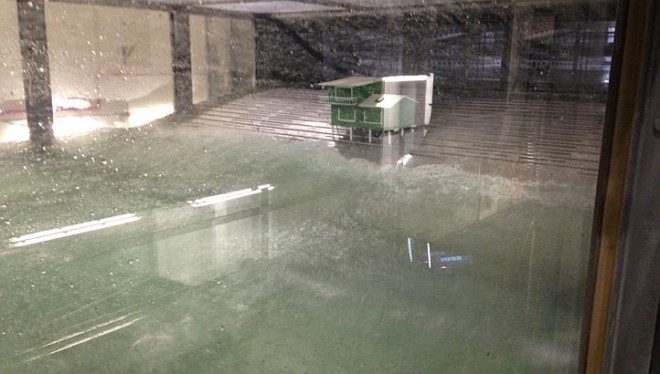World’s biggest hurricane simulator aims to improve forecasts

A miniature house is perched at one end of the world’s largest indoor hurricane simulator at the University of Miami Rosenstiel School of Marine and Atmospheric Sciences, in Miami, Florida known as SUSTAIN (short for SUrge-STructure-Atmosphere Interaction) on April 30. (AFP)
MIAMI — The world’s largest hurricane simulator is now complete and experts hope it will improve forecasters’ ability to predict how strong a storm will get, which has been a key weak spot for science until now.
The US$15 million (S$19.95 million) wind and wave machine at the University of Miami Rosenstiel School of Marine and Atmospheric Science resembles a giant aquarium tank, without the fish.
When lead scientist Brian Haus switches on the 1,700 horsepower engine, a roaring sound fills the US$47 million building that houses the tank, known formally as SUSTAIN (SUrge-STructure-Atmosphere INteraction Facility).
Paddles begin to roil the 144,000 litres of fresh water, though salt water can also be used.
Aquamarine waves arc gracefully against the acrylic windows, then grow increasingly frenetic as a Category 5 wind blows over the top at a speed of 251 kmph.
Soon, spray droplets scatter across the sides of the steel-framed tank, which measures 23m long, 6m wide and 2m deep.
A miniature model of a green-and-white house gets drenched by crashing waves that resemble a real-life storm surge assaulting a coastal property.
Haus, a self-described “wave-junkie”, stares intently at the indoor storm he has helped create.
A “key component of SUSTAIN will be to improve hurricane intensity forecasting,” he explains later in his office, since anything but shouted conversations are difficult to maintain near the tank.
“Over the last 20 years our track forecasts have been getting better and better. But the thing that hasn’t gotten any better over the past 20 years is hurricane intensity forecasts.”
Perhaps the best example of a storm that outwitted even the most seasoned forecasters was Hurricane Wilma in 2005. It exploded in strength over Mexico, rising from Category 2 to 5 in a matter of hours.
“That is the thing that really scares forecasters because it makes it hard for them to do their job,” Haus says.
Wilma became the most intense Atlantic hurricane on record, killing dozens of people and causing tens of billions of dollars in damage.
Living through Wilma and the far deadlier Hurricane Katrina, known for causing mass devastation in Louisiana and the Gulf of Mexico that same year, propelled Haus to find ways of better understanding the physics of storm strength, and how the warmth of the ocean can power a hurricane.
Researchers also hope to use SUSTAIN – which is six times larger than any wind-water hurricane simulator ever built – to explore how storms will damage homes and buildings along the coast.
“This is important because most of our building codes and models for how we build in coastal areas are not based on any real information about what happens in these conditions,” says Haus.
Other groups, such as the Insurance Institute for Business and Home Safety in South Carolina, recreate high winds, hail storms and even wildfires using life-sized homes.
But even placing sensors on the miniature house inside the SUSTAIN tank to study how it is affected by a storm can help scientists, according to Paul Wilson, vice president of model development at RMS (Risk Management Solutions) in London.
“Understanding how buildings respond to extreme weather events, those are projects which we find incredibly useful. They just add to the body of knowledge on which our models are based.”
Miami is home to many storm researchers, including the National Hurricane Center, the National Oceanic and Atmospheric Administration (NOAA) Hurricane Research Division, and Florida International University which houses a Wall of Wind that simulates Category 5 hurricane gusts.
NOAA and the US Air Force regularly send aircraft into the heart of hurricanes, where pilots drop parachute-lofted tubes, called sondes, to measure how the wind changes with height just above the sea surface.
Mark Powell, a former NOAA scientist who flew some of those missions into hurricanes and now heads a company called HWind Scientific, says SUSTAIN “has a lot of promise for research,” and is hopeful that the enthusiasm will spread beyond the tank itself.
“When you have a big facility like the SUSTAIN facility, there is a tendency to focus on the facility and the type of work it can do, but there is a human element too,” adds Powell.
“So what I hope will happen with that facility is that there is a much stronger interaction between all the talent in the Miami area. They need to interact to really make breakthroughs.”














